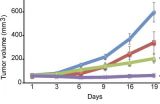(Press-News.org) Reducing Maternal Mortality In Zambia and Uganda. Margaret E. Kruk of Columbia University and co-authors assessed the effectiveness of Saving Mothers, Giving Life, a new global public-private partnership that aims to reduce maternal mortality in eight districts in Uganda and Zambia. They evaluated the first six to twelve months of the program's implementation, its ownership by national ministries of health, and its effects on health systems. According to the authors, early benefits to the broader health system included greater policy attention to maternal and child health, new health care infrastructure, and new models for collaborating with the private sector and communities. However, they also found that the rapid pace, external design and lack of a long-term financing plan hindered integration into the health system and local ownership.
If you're between ages 15-39 when you are diagnosed with cancer, the implications later in life extend well beyond your health. Gery P. Guy Jr. of the Centers for Disease Control and Prevention and coauthors examined Medical Expenditure Panel Survey data and determined that survivors of adolescent and young adult cancers had annual per person medical expenditures of $7,417 (USD), compared to $4,247 for adults without a cancer history. They also found an annual per capita lost productivity of $4,564 per cancer survivor compared to $2,314 for adults without a cancer history. They suggest that the disparities are associated with ongoing medical care needs and employment challenges connected to cancer survivorship, and that having health insurance alone is not enough to close the gap. The authors stress the importance of access to lifelong follow-up care and education to help lessen the economic burden of this important population of cancer survivors.
Marketing Barriers For Biosimiliars. Because bringing biosimilars to the market currently requires large investments of money, fewer biosimilars are expected to enter the U.S. biologics market than has been the case with generic drugs entering the small-molecule drug market. Henry G. Grabowski of Duke University and co-authors examine the legislation passed by Congress in 2010 to establish an abbreviated FDA approval pathway for biosimiliars. They found that biosimilars will need to compete with their reference product on the basis of quality; price; and manufacturer's reputation with physicians, insurers and patient groups. Biosimilars also will face dynamic competition from new biologics in the same therapeutic class—including "biobetters," which offer incremental improvements on reference products, such as extended duration of action. The prospects for significant cost savings from the use of biosimilars, say the authors, appear to be limited for the next several years, but their use should increase over time because of both demand- and supply-side factors.
INFORMATION:
NOTE: Publication of Health Affairs' June 2014 issue also marks the arrival of Alan Weil as its new editor-in-chief. Weil, a highly respected expert in health policy, has been the executive director of the National Academy for State Health Policy (NASHP) since 2004. Prior to his leadership of NASHP, Weil served in both the public and private sectors. He directed the Urban Institute's "Assessing New Federalism" project; was the executive director of the Colorado Department of Health Care Policy and Financing and a health policy advisor to Colorado's then-governor, Roy Romer; and was the assistant general counsel in the Massachusetts Department of Medical Security. To read more about Alan Weil and his vision for Health Affairs, visit Health Affairs Blog.
Health Affairs is the leading journal at the intersection of health, health care, and policy. Published by Project HOPE, the peer-reviewed journal appears each month in print, with additional Web First papers published periodically and health policy briefs published twice monthly at http://www.healthaffairs.org. Read daily perspectives on Health Affairs Blog. Download monthly Narrative Matters podcasts on iTunes. Tap into Health Affairs content with the new iPad app.
Health Affairs asks: Where can we find savings in health care?
2014-06-09
ELSE PRESS RELEASES FROM THIS DATE:
Common bean genome sequence provides powerful tools to improve critical food crop
2014-06-09
Huntsville, Ala. – String bean, snap bean, haricot bean, and pinto and navy bean. These are just a few members of the common bean family — scientifically called Phaseolus vulgaris. These beans are critically important to the global food supply. They provide up to 15 percent of calories and 36 percent of daily protein for parts of Africa and the Americas and serve as a daily staple for hundreds of millions of people.
Now, an international collaboration of researchers, led by Jeremy Schmutz of the HudsonAlpha Institute for Biotechnology and Phillip McClean, of North Dakota ...
Sequencing of citrus genomes points to need for more genetic diversity to fight disease
2014-06-09
Huntsville, Ala. – Sequencing the genomes of domesticated citrus revealed a very limited genetic diversity that could threaten the crop's survival prospects, according to an international research team. In a study published in the June issue of Nature Biotechnology, the international consortium of researchers from the United States, France, Italy, Spain and Brazil analyzed and compared the genome sequences of 10 diverse citrus varieties, including sweet and sour orange along with several important mandarin and pummelo cultivars. The findings provide the clearest insight ...
Combination therapy may help patients with follicular lymphoma
2014-06-09
A new study in The Journal of Experimental Medicine reveals that a high-risk group of patients with follicular lymphoma could benefit from a novel drug combination.
Follicular lymphoma, a B cell lymphoma, is an incurable form of non-Hodgkin lymphoma that is diagnosed each year in 120,000 people worldwide. Follicular lymphoma is characterized by slow and relentless tumor growth with inevitable relapses despite intense chemotherapy. Follicular lymphomas are driven by mutations that activate the BCL2 protein, which prevents cancer cells from dying, but additional genetic ...
No limits to human effects on clouds
2014-06-09
Understanding how clouds affect the climate has been a difficult proposition. What controls the makeup of the low clouds that cool the atmosphere or the high ones that trap heat underneath? How does human activity change patterns of cloud formation? The research of the Weizmann Institute's Prof. Ilan Koren suggests we may be nudging cloud formation in the direction of added area and height. He and his team have analyzed a unique type of cloud formation; their findings, which appeared recently in Science indicate that in pre-industrial times, there was less cloud cover over ...
UNC researchers pinpoint new role for enzyme in DNA repair, kidney cancer
2014-06-09
CHAPEL HILL, N.C. – Twelve years ago, UNC School of Medicine researcher Brian Strahl, PhD, found that a protein called Set2 plays a role in how yeast genes are expressed – specifically how DNA gets transcribed into messenger RNA. Now his lab has found that Set2 is also a major player in DNA repair, a complicated and crucial process that can lead to the development of cancer cells if the repair goes wrong.
"We found that if Set2 is mutated, DNA repair does not properly occur" said Strahl, a professor of biochemistry and biophysics. "One consequence could be that if you ...
Did violence shape our faces?
2014-06-09
(Salt Lake City) —What contributed to the evolution of faces in the ape-like ancestors of humans?
The prehistoric version of a bar fight —over women, resources and other slug-worthy disagreements, new research from the University of Utah scheduled for publication in the journal Biological Reviews on June 9 suggests.
University of Utah biologist David Carrier and Michael H. Morgan, a University of Utah physician, contend that human faces —especially those of our australopith ancestors — evolved to minimize injury from punches to the face during fights between males. ...
Iron supplements improve anemia, quality of life for women with heavy periods
2014-06-09
A study by researchers from Finland found that diagnosis and treatment of anemia is important to improve quality of life among women with heavy periods. Findings published in Acta Obstetricia et Gynecologica Scandinavica, a journal of the Nordic Federation of Societies of Obstetrics and Gynecology, suggest clinicians screen for anemia and recommend iron supplementation to women with heavy menstrual bleeding (menorrhagia).
One of the common causes of iron deficiency and anemia is heavy bleeding during menstration. Over time monthly mentrual iron loss without adequate ...
Most breast cancer patients may not be getting enough exercise
2014-06-09
Physical activity after breast cancer diagnosis has been linked with prolonged survival and improved quality of life, but most participants in a large breast cancer study did not meet national physical activity guidelines after they were diagnosed. Moreover, African-American women were less likely to meet the guidelines than white women. Published early online in CANCER, a peer-reviewed journal of the American Cancer Society, the findings indicate that efforts to promote physical activity in breast cancer patients may need to be significantly enhanced.
The US Department ...
Longer telomeres linked to risk of brain cancer
2014-06-08
New genomic research led by UC San Francisco (UCSF) scientists reveals that two common gene variants that lead to longer telomeres, the caps on chromosome ends thought by many scientists to confer health by protecting cells from aging, also significantly increase the risk of developing the deadly brain cancers known as gliomas.
The genetic variants, in two telomere-related genes known as TERT and TERC, are respectively carried by 51 percent and 72 percent of the general population. Because it is somewhat unusual for such risk-conferring variants to be carried by a majority ...
New molecule enables quick drug monitoring
2014-06-08
Monitoring the drug concentration in patients is critical for effective treatment, especially in cases of cancer, heart disease, epilepsy and immunosuppression after organ transplants. However, current methods are expensive, time-consuming, and require dedicated personnel and infrastructure away from the patient. Publishing in Nature Chemical Biology, scientists at EPFL introduce novel light-emitting sensor proteins that can quickly and simply show how much drug is in a patient's bloodstream by changing the color of their light. The method is so simple that it could be ...




